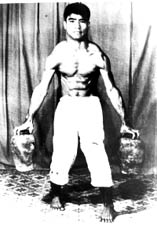
|

|
|

|

|

|
|

|
Condensed from " The Secrets of Uechi Ryu Karate and The Mysteries of Okinawa"
|
The Shinjo family is one of the
most dynamic and renowned names of traditional Okinawan
karate. Three generations of Shinjo men have helped mold the
history of this unique karate style. The history of this
karate family parallels the growth of Pangainoon and Uechi
ryu karate from the time Kanbun Uechi first taught martial
arts outside China.
|
|
Seiryo ShinjoSeiryo Shinjo (formerly called Seizan
Shinjo) was born on Ie-Jima Island, June 10, 1908. His
father, Seisan Shinjo, was a well-known bo expert on
Ie-jima
Seiryo traveled to Wakayama seeking employment in 1923, one year before Kanbun Uechi. Seiryo found a job with the same company that Kanbun later would, the Himomaru Sangyo Kabushki Kaisha, a boseki factory. He eventually heard stories of Kanbun and that he was now teaching |
|
|
Seiryo Shinjo entered the Shataku dojo
of Kanbun Uechi early in 1927. He and his wife Tsuru,
whom he had met in Wakayama, were married later the same
year.
Seiryo Shino was a small agile man who became known for his incredibly fast kicks. Hisaguwa Seizen (fast kicker Seizen) was the nickname given to him by his peers. Seiryo was a quiet, gentle man who would not quarrel with anyone. Kanbun grew to like him very much and they became the best of friends. Kanbun felt comfortable with Seiryo and Tsuru. Their house was the only place he could relax and express himself. It became a gathering place for Seiryo's friends including Kanbun, who was present for the birth of their daughter, Sayako. |
|
Seiyu Shinjo, the Shinjo's first son, was Born July 10,1929. Kanbun became fond of the exuberant young Seiyu, who pleaded for years with his father to let him study karate. Seiyu became a student at Kanbun Uechi's Tebira dojo in 1939. He was ten years old. Seiyu and other new students performed cleanup and other duties around the dojo. |
|
|
The first three months of training
consisted of doing Sanchin steps across the dojo. Holding
his arms in the proper position was added to the stepping,
the following three months.
The rambunctious young man complained daily to his father that they had done the same thing in class again. Seiyu remained determined to learn karate. Eventually Seiryo began teaching his son at home, in addition to Kanbun's teachings. Seiyu Shinjo was exposed to an unprecedented learning opportunity for nine years. The harsh conditions in Japan after the war facilitated the decision to return to Okinawa. The Shinjo family traveled with Seiko Toyama and Kanbun Uechi. Seiyu was leaving the only home he had every known.
RETURN TO OKINAWA AND IE-JIMA ISLANDThe group was interred in a prison of war camp for six months, when they returned to Okinawa. To lift moral in the camp, Kanbun demonstrated karate. It was the only time his students saw him perform all the katas in their entirety. In Japan he always taught explosive individual moves from a kata, ikyodo, but never demonstrated the entire kata. After release from the camp the Shinjo family and Kanbun Uechi relocated on Ie-jima Island where he died on November 25, 1948. The Shinjo's were the only ones present.
|
|
Kiyohide ShinjoOn November 3,1951 Ie-jima Island
produced a modern day karate legend name Kiyohide Shinjo. He
began karate training, not by his own choice, when he was
ten years old.
Seiyu was a hard man concerning karate. He maintained the uncompromising, sometimes inhuman, standard of training established by Kanbun Uechi. |
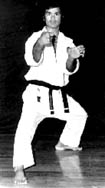 |
|
Intoxicated servicemen often found
their way into the dojo, challenging the Okinawans to fight,
in those days. Seiyu Shinjo often ordered his son to fight
the belligerent Americans. For many years the skinny young
Okinawan was beaten by the challengers. As Kiyohide's size,
strength, and karate ability increased, so did his dislike
for American servicemen. In time Kiyohide won every fight
with great pleasure
Tournament HistoryIn 1968, The Uechi Ryu Karate Shubukai held the first annual Uechi ryu tournament. It included kata (forms) and kumite (sparring) competition for black belts. Seiyu Shinjo was the organizer and tournament director. His son Kiyohide, placed third in kata in the inaugural tournament. At the third annual tournament in 1970, Kiyohide Shinjo won the championship in both kata and kumite. He continued to do so for a record nine years. He became a legend in Okinawa in the process and is often called "Okinawa's Superman" In 1978, the eighth year of his championship reign, the first All Okinawa Championship Tournament was held. The champion of this historic sparring event, open to black belts of all karate styles, was Kiyohide Shinjo. He retired from competition after the 1980 Uechi ryu tournament, due to the ill health of his father. The Uechi ryu tournament ran uninterrupted for twenty years until the break up of the Uechi Ryu Association in 1988. The Kadena dojo won the championship in fifteen of the twenty tournaments. |
|
Narahiro ShinjoNarahiro Shinjo, Seiyu's second son,
is often lost in the shadow of his famous brother. Narahiro
also inherited his father's vigor and relentless approach to
karate and is every bit as accomplished as his older
brother. He has also traveled internationally teaching and
demonstrating Uechi ryu karate.
|
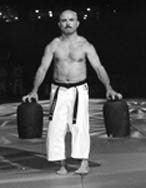 |
|
Narahiro Shinjo placed first in kata
in five of the eight Uechi ryu tournaments following his
brother's retirement. He placed 4th in the Okinawan world
tournament in 1997.
The Shinjo Dojo of Kadena, Okinawa is often called upon by the Government to perform demonstrations in Okinawa and around the world. Seiko Toyoma and Kiyohide Shinjo were given the honor of performing karate for the President of the United States and other world leaders at the G-Eight Summit in Okinawa in June 2000 The Shinjo family is one of vigorous strength who live by the code of Gosatu Bokuto… "Live life easy and peacefully, but when it is time to fight become ferocious." |
|
|
In 1981, Kiyohide Shinjo started the Kenyukai fraternity within the Uechi Ryu Association in honor of his father who died that year. The new emblem was worn on the left sleeve of the gi by all black belts from the Kadena dojo. This innovation soon caught on in the Association and various dojo names began appearing on Uechi ryu gi's. Kenyukai is the organization name for the black belts of Uechi Ryu Karate who were taught by Seiyu Shinjo. |
YU - SEIYU KAI - GROUP |
 |
Master Toyoma is a wellspring of information about the
history of Uechi Ryu karate and a robust storyteller. He is
the Senior Technical Advisor to the Kenyukai
Association.
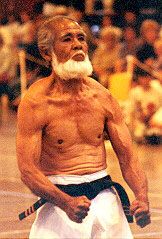
One of the most senior black belts of Seiyu Shinjo is
Tsutomu Nakahodo, born November 25, 1933. He first started
karate training under Seiko Toyama in 1955, and became a
student of the Kadena dojo in 1960. Mr. Nakahodo is referred
to as "Popeye," because of his massive forearms and brute
strength. In 1995, Master Nakahodo was awarded 9th Dan by the All
Okinawan Karate Association. Master Nakahodo made gave this stirring tribute about his
Sensei, Seiryo Shinjo:
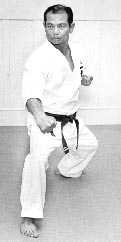
Master Gushi and family moved to Southern
California in 1989. He teaches his style of Uechi Ryu karate
under his own association, Ryukokakuken.

